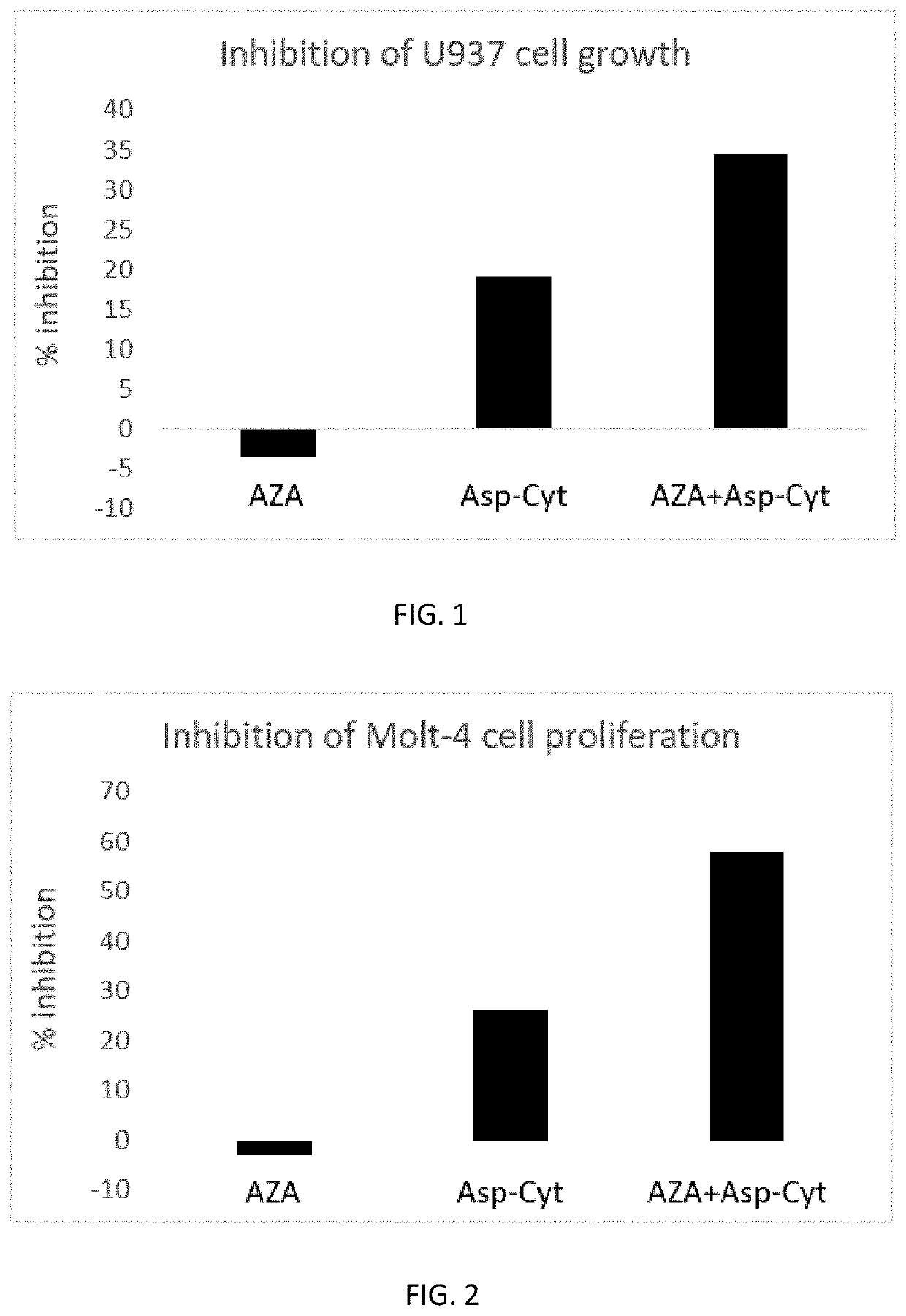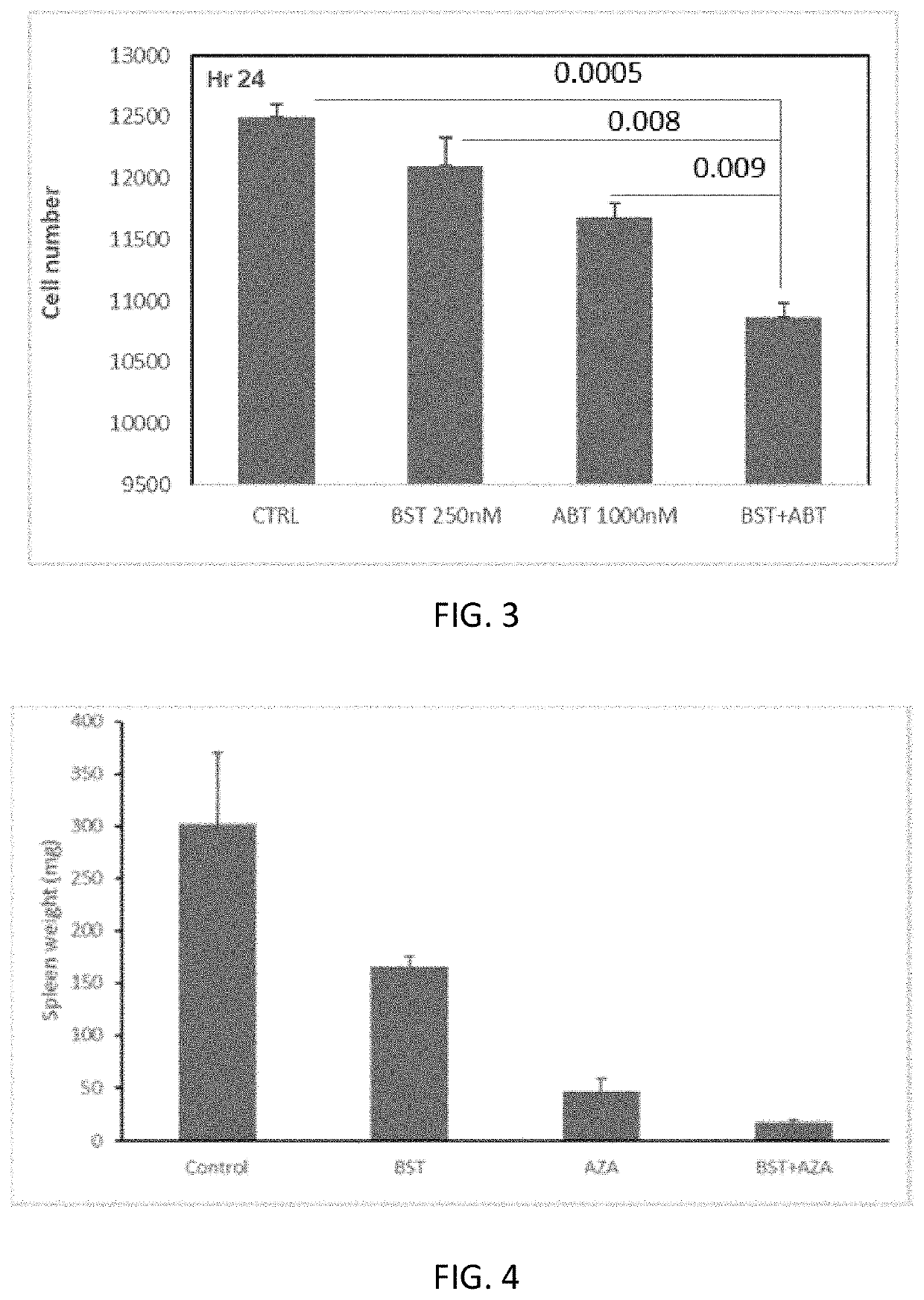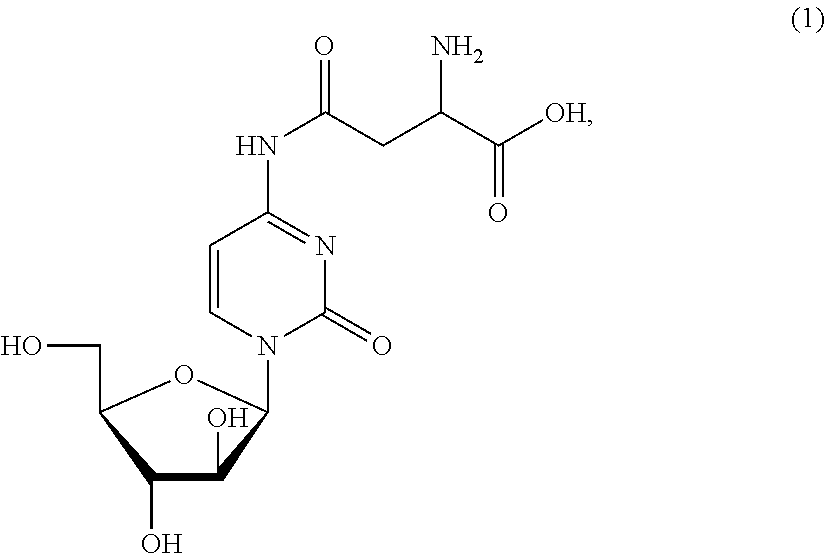Combination cancer therapy
a cancer therapy and cytarabine technology, applied in the field of combination therapies, can solve the problems of limited use as therapeutic agents, high toxicity to normal cells, inherent or acquired resistance of tumors to drugs, etc., and achieve the effect of reducing cancer burden and cancer cell proliferation
- Summary
- Abstract
- Description
- Claims
- Application Information
AI Technical Summary
Benefits of technology
Problems solved by technology
Method used
Image
Examples
example 1
Effect of Asp-Cytarabine / BST-236 and Azacitidine (Vidaza) on Proliferation and Survival of U937 Cells
[0391]U937 human hematological cancer cells were cultured in RPMI supplemented with 10% FCS. The cells were seeded at 1×105 cells / well in a total volume of 250 μl in a 96-well plate. Azacitidine (AZA) was added to the cell cultures at 5 different concentrations: 0, 100, 250, 1000, 5000 nM. Asp-Cytarabine, also designated herein below BST-236, was added to the culture at a concentration of 250 nM. All groups were analyzed in triplicates. After 72 hours of incubation at 37° C. with 5% CO2, the cells were collected, stained with propidium iodide (PI), and immediately read by FACS. The number and percentage of viable (PI-negative) cells and the number and percentage of dead (PI-positive) cells in the culture were determined by FACScalibur using CellQuest software. The percentage of inhibition was calculated.
TABLE 2Percentage of growth inhibition of U937 cells treated with Asp-Cytarabine,...
example 2
Effect of Asp-Cytarabine and Azacitidine on Molt-4 Cell Proliferation
[0394]Molt-4 human leukemia cell line was obtained from ATCC. The cells were grown in RPMI medium containing 10% FBS and 1% glutamine Cells were seeded in 96-well plates, 50,000 cells / ml, 0.2 ml per well. Test substances were diluted in PBS and added in final concentrations of 0.1 nM to 10 μM, in a volume of 20 μl. The study was conducted in triplicates. PBS was used as a control. Plates were incubated for 72 hr at 37° C. with 5% CO2. At the end of the treatment period, a MTT assay using the MTT reagent [3-(4,5-dimethylthiazol-2-yl)-2,5-diphenyltetrazolium bromide] was performed. MTT was added to each well at a concentration of 5 mg / ml in a volume of 0.02 ml. Plates were incubated at 37° C. for 3 hours. The plates were centrifuged at 3500 rpm for 5 minutes and the supernatant was aspirated. The pellets which contained MTT crystals were each dissolved in 0.2 ml DMSO. Absorbance was determined using ELISA reader at a...
example 3
Effect of Asp-Cytarabine and ABT-199 (Venetoclax) on Proliferation and Survival of U937 Cells
[0398]U937 cells were cultured in RPMI supplemented with 10% FCS and seeded at 1×105 cells / well in a total volume of 250 μl in a 96-well plate. ABT-199 was added to the cell cultures at 3 different concentrations: 0, 250, and 1000 nM. Asp-Cytarabine was added to the culture at a concentration of 250 nM. All groups were analyzed in triplicates. After 24 hours of incubation at 37° C. with 5% CO2, the cells were collected and stained with propidium iodide (PI) and immediately read by FACS. The number and percentage of viable (PI-negative) cells and the number and percentage of dead (PI-positive) cells in the culture were determined by FACScalibur using CellQuest software. The percentage of inhibition was calculated.
[0399]As shown in FIG. 3, the combined treatment of human hematological cancer cells with Asp-Cytarabine and ABT-199 for 24 hours resulted in a significant inhibition of the prolifer...
PUM
| Property | Measurement | Unit |
|---|---|---|
| molecular weight | aaaaa | aaaaa |
| osmolarity | aaaaa | aaaaa |
| osmolarity | aaaaa | aaaaa |
Abstract
Description
Claims
Application Information
 Login to View More
Login to View More - R&D
- Intellectual Property
- Life Sciences
- Materials
- Tech Scout
- Unparalleled Data Quality
- Higher Quality Content
- 60% Fewer Hallucinations
Browse by: Latest US Patents, China's latest patents, Technical Efficacy Thesaurus, Application Domain, Technology Topic, Popular Technical Reports.
© 2025 PatSnap. All rights reserved.Legal|Privacy policy|Modern Slavery Act Transparency Statement|Sitemap|About US| Contact US: help@patsnap.com



